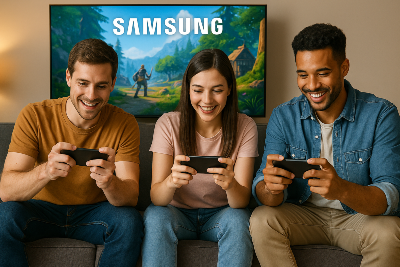Batch Planning vs. Agile Supply
🌀Why the Smartest DTC Brands Are Shipping on Signal, Not on Schedule, Samsung Ads Wants to Turn CTV Watchers Into Mobile Gamers, and more!

Hey there Smarty 👋
Are you geared up to catch the latest and greatest in quick shorts?
And just a quick heads-up! If you stumbled upon us through a friend, make sure to subscribe here! That way, you’ll never miss out on the trending shorts.

🌀 Batch Planning vs. Agile Supply: Why the Smartest DTC Brands Are Shipping on Signal, Not on Schedule
DTC logistics used to be about buying in bulk and hoping the forecast was right.
Today, it’s about velocity over volume, about responding to demand in motion, not predicting it in spreadsheets. Because the brands that win now aren’t planning further out… they’re turning faster.
Batch Planning Is the Slow Death of Creativity
The old model looked like this:
- Predict Q3 demand in Q1
- Lock 10K+ units into ocean freight
- Wait 60–90 days to see what hits
It’s slow, risky, and brutally expensive if you guess wrong. You either sit on dead stock, or worse, go out of stock right when your campaign pops.
Batch planning punishes creative momentum. And in a post-iOS world, creativity is your momentum.
Meet the AFS Loop: Agile Fulfillment for Scale
Here’s the model the best brands now run:
AFS Loop = Demand Signal → Rapid Production → SKU-Level Shipments → Loopback Adjustments
It’s built around reactional velocity, not bulk discounting.
SKU performance isn’t “evaluated quarterly”—it’s watched daily, acted on weekly.
Imagine launching a UGC-led bundle test on Monday…
…having the top combo manufactured by Thursday…
…and shipping orders globally by the weekend.
Contact Portless to enable weekly manufacturing runs with daily outbound. When fulfillment moves at the speed of creativity, every test becomes a growth loop, not a guess.
The Cash Delta No One Talks About
Let’s run the math:
That’s $400K in freed capital, and a radically tighter feedback loop. More importantly? You stop gambling. You start compounding.
Why This Changes Everything
Agile supply shifts your entire go-to-market motion:
- Campaigns get mapped to SKU agility, not just ad timing
- Seasonal bets become rolling micro-drops, not static inventory bets
- Inventory becomes a media tool, not a liability
Your ops team stops saying “We can’t do that.” They start asking: “How fast do you want it to live?”
Forecasting demand is a relic.
The real unlock is shaping demand through logistics agility, letting your ops follow the story, not hold it back. Move smaller. Move faster. Ship smarter. Because in DTC now, the best creative isn’t just launched, it’s fulfilled in motion.

Together with Insense
Drive 53% Higher ER with Meta Partnership Ads on Insense
Struggling with CPA and low engagement?
Why? Your traditional branded ads are likely getting overlooked, especially as consumers increasingly doubt AI-generated and branded content.
Solution? Meta Partnership Ads. Leverage influencer authenticity to boost your ad credibility and performance.
2,000+ major eComm brands, including LARQ, JLO Beauty, Bones Coffee, and Babbel, trust Insense to simplify their UGC and influencer partnerships for organic and paid social campaigns.
Here’s why eComm brands choose Insense to run Meta Partnership Ads:
- Higher Engagement: MPA delivers a 53% higher CTR and a 19% lower CPA compared to traditional brand ads.
- Seamless Setup: Insense offers a 1-click integration directly into your Facebook Ads Manager, allowing effortless management of influencer handles and permissions.
- Proven Social Proof: Combine authentic UGC with influencer-driven ads to instantly enhance ad authenticity and build consumer trust.
- Effortless Scaling: Quickly collaborate with 68,500+ vetted creators from 35+ countries to scale your ad campaigns efficiently.
Try Insense now.
Book your free demo now and receive $200 towards your first MPA campaign!
Offer expires July 25, 2025!

📲 Samsung Ads Wants to Turn CTV Watchers Into Mobile Gamers
Samsung just unveiled Mobile Conversion, a new ad product designed to help gaming brands convert CTV viewers into mobile app users. It's currently built for gaming but will expand to retail, travel, and other verticals.

The Breakdown:
1. CTV-to-Mobile, powered by AI - Samsung’s system uses AI and machine learning to identify high-intent users and adjust bidding and creative dynamically. It leverages Samsung TV Plus inventory and its own closed-loop ecosystem for smarter targeting and security. Beta testing showed up to 150% ROAS index on Day 7, surpassing client benchmarks.
2. Unified view across screens - The product connects viewing behavior on TV to installs on mobile, solving a long-standing measurement gap. It integrates with platforms like AppsFlyer and Adjust for full-funnel visibility.
3. Next up: More industries - Mobile Conversion will expand to QSR, retail, entertainment, and financial services. With 75% of U.S. households owning a Samsung device, the brand is uniquely positioned to bridge TV and mobile.
Marketers are hungry for new cross-channel wins as the mobile app install space gets saturated. Samsung’s Mobile Conversion turns passive CTV audiences into active mobile users with precision targeting and measurable ROI, unlocking a fresh channel for full-funnel growth.

🚀Quick Hits
🎥 Still repeating the same SOPs over Zoom and Slack? Guidde turns any screen task into a step-by-step video with voiceover, 11x faster than writing docs. Just hit capture and share anywhere. Try the free Chrome extension today!
💔 xAI launched animated AI companions like “Ani” and “Bad Rudy” for SuperGrok subscribers, enabling flirty, even NSFW, conversations, raising ethical, emotional, and mental health concerns over AI intimacy.
🧵Threads is testing Facebook-based signups, letting users create accounts using their Facebook profiles instead of Instagram.
📩 Google is testing a Gmail ad format that turns the Promotions tab into a shoppable carousel, combining Demand Gen targeting with rich product listings.
🔍 Google says AI won't replace SEO. Chatbots still rely on websites for answers, especially for local search and ecommerce, so knowing how to optimize sites remains essential in the AI era.

That’s a wrap for today! Tell us your thoughts about today's content as we line up more Shorts! And don’t hesitate to share this with someone who’d adore it. 🥰
